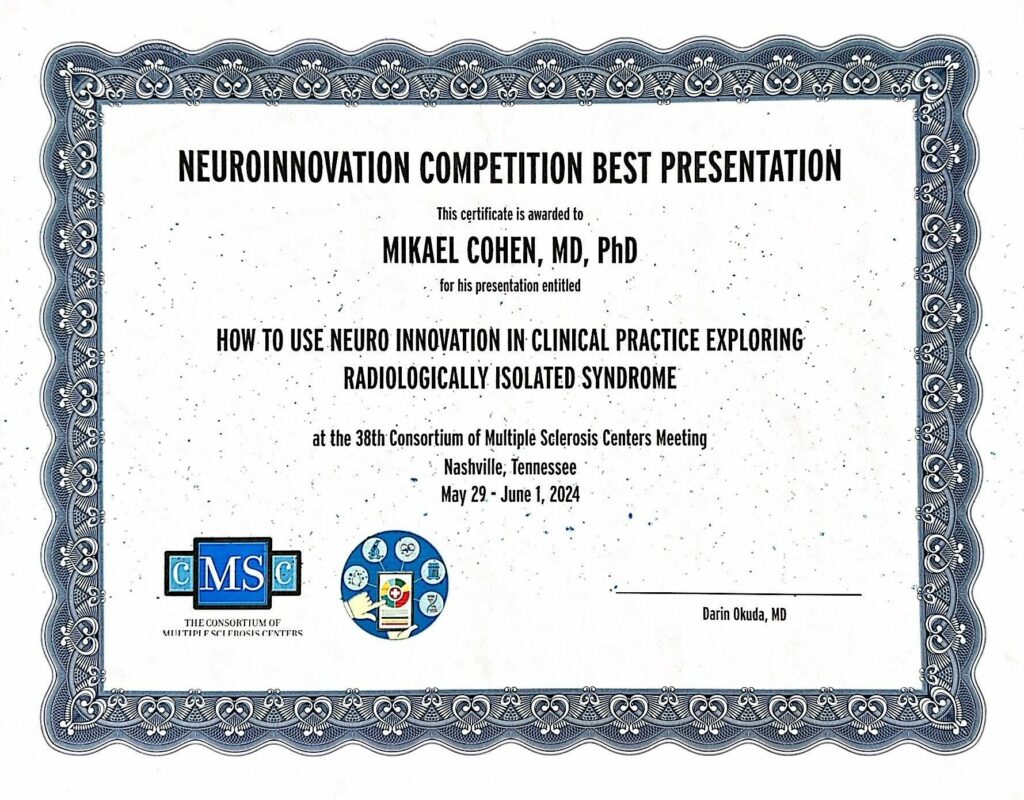We know that most of neurodegenerative diseases start years before the first clinically detectable abnormalities, both for the patient and for the physician using a traditional neurological exmination.
Could Neuraccure apps allow for an earlier diagnosis? We tested this hypothesis in individuals that were identified with a radiologically isolated syndrome.
What is the radiologically isolated syndrome (RIS)?
The RIS is defined by the unexpected discovery of brain MRI abnormalities suggestive of MS in individuals who had a scan for an unrelated reason like headaches, or mild traumatic brain injury. It has been defined in 2009 (Okuda et al., Neurology) and revised diagnostic criteria were published in 2023 (Lebrun et al., Brain).
Why did we test Neuraccure apps in RIS individuals?
RIS is defined by the absence of any complain that could be related to multiple sclerosis and by the normality of the traditional neurological examination.
However, observational studies revealed that nearly 50% of RIS individuals will be diagnosed with MS ten years after the first MRI scan (Lebrun et al., Ann Neurol, 2020). Consequently RIS is a very good model of chronic neurological disease detected at the preclinical stage where the traditional examination is unremarkable.
How did we test Neuraccure apps in RIS individuals?
RIS individuals were tested using Neuraccure apps and we performed the same evaluation in age-matched healthy controls. It was then possible to compare the performances of both groups to evaluate whether the digital measures were able to distinguish individuals with a very high risk of developing MS.
What did Synapse revealed in RIS individuals?
Using Synapse, our results confirmed that RIS individuals differed from healthy controls on all of the performed tasks.
Recording eye movements using Vision also allowed us to demonstrate that RIS individuals had in average nearly 3 abnormalities on their exam in comparison to 1 in the control group.

As a conclusion, we were able to demonstrate that among a cohort of healthy controls and RIS individuals, Neuraccure apps were able to classify individuals in the proper group with an accuracy of 82.9%.
Those results allowed us to obtain the Neuroinnovation award at the 2024 Consortium of Multiple Sclerosis Center Congress
References
Cohen M, Mondot L, Fakir S, Landes C, Lebrun C. Digital biomarkers can highlight subtle clinical differences in radiologically isolated syndrome compared to healthy controls. J Neurol. 2021 Apr;268(4):1316-1322. doi: 10.1007/s00415-020-10276-w. Epub 2020 Oct 19. PMID: 33078309.
Cohen M, Hesse S, Polet K, Louchart de la Chapelle S, Morisot A, Bresch S, Pesce A, Lebrun-Frenay C. Reliability of mobile video-oculography in multiple sclerosis patients using an iPad: A prospective validation study. Mult Scler Relat Disord. 2022 Aug;64:103944. doi: 10.1016/j.msard.2022.103944. Epub 2022 Jun 6. PMID: 35679780.
Cohen et al., Abstracts from the 38th Annual Meeting of the Consortium of Multiple Sclerosis Centers: May 29-June 1, 2024 · Nashville, Tennessee. Int J MS Care 26 May 2024; 26 (s1): 1–104. doi: https://doi.org/10.7224/1537-2073-26.s1.1